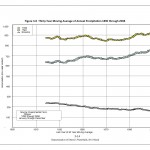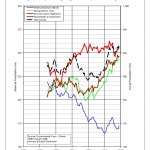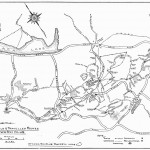 When Charles Mortureaux bought the shack that founded Camp Fortune in 1920, Ottawa was a snowier place.
When Charles Mortureaux bought the shack that founded Camp Fortune in 1920, Ottawa was a snowier place.
It’s not just the old fogies who say we used to get more snow, Environment Canada statistics prove it.
The City of Ottawa has just produced a study of watersheds within its municipal boundaries. Part of this study looks at Ottawa’s climate and part of the review of climate looks at precipitation (as one might expect when examining watersheds).
 Check out these two graphs from the study (above and to the right here, click each for enlarged version).
Check out these two graphs from the study (above and to the right here, click each for enlarged version).
Applying the simple formula that one centimeter of snow equals one millimetre of rain, Figure 3-8 appears to be telling us that in Mort’s day the Experimental Farm was blanketed with almost 2½ metres of snow over the winter.
Do my eyes deceive me or does it look to you as if today we get only something over 1½ metres.
Figure 3-9 shows that even as rain has been increasing in every other season, in winter precipitation has been decreasing. Which is to say the amount of snow falling is falling.
It was 2005 when the NCC’s study warned us that by 2050 there might not be any skiing in Gatineau Park.
Aside – it’s a nice coincidence that Mort worked for what became Agriculture Canada and the data for the City of Ottawa study was collected at the Experimental Farm.



We need to change our ways of thinking,or we will have no earth for our children!!!!
Since the data was collected at the experimental farm, I wonder how much the growth of the City over 90 years, has affected the ubran micro climate. I live in north Hull & it’s often snowing there while it’s raining down in the City.
That would account for precipitation that fell as rain instead of snow, but the second graph clearly shows that there is plain old less precipitation of any kind in winter compared to decades past (it’s that blue line going down while others are going up).
I scratched my head and asked Environment Canada directly. This is what they said:
So I did. And what do I see?
Click on the graph above to enlarge it. I know the old saying that there are 3 kinds of lies; lies, damn lies, and statistics. But it still looks to me like we’re getting less snow than in days of old.
But those early ’70s sure look like great skiing!
Interesting… it looks like there’s a number of data sets for different stations in Ottawa. I’m going to have to dig into it a bit further, because I may have used a different one from the set you’ve analysed. One question: Did you break the data on the calendar year or on July 1st so that you can deal with the winters.
But, you’re right: lies, damn lies, and statistics.
Cut and pasted as EC presented it, which was by calendar year. So yes, each winter was split in two. The City of Ottawa analysis splits at winter solstice and spring equinox.
Yeah… looking at it by calendar year will give slightly different results when trying to calculate how much snow fell in the winter. Splitting at the winter solstice and spring equinox basically splitting it on the seasonal boundaries, which causes a bunch of snow in the weeks before the third week of December to not be counted in what most people think of when they think of the winter snow season (as opposed to the winter season).
Pingback: Will Declining Ottawa Precipitation Spell the End of XC and Snowshoeing? | OutdoorOttawa
Thanks Gordon & Charles. I thoroughly enjoyed following the statistics you outline and the debate over precipitation amounts recorded between the Environment Canada station and the Experimental Farm one. My husband and I used to live closer to the airport and noticed then that our rain/snow fall amount was similar to Environment Canada’s. Since we moved downtown 3 years ago, however, we now see a big discrepancy. Watching the radar shows us why: precipation falls on different parts of the city at different times (temperature also varies between here and the airport). I’ve begun to think that Environment Canada needs a separate recording station downtown.
Thanks again – I’ll keep an eye on both your blogs in the future.